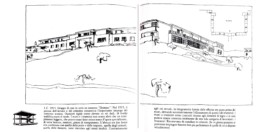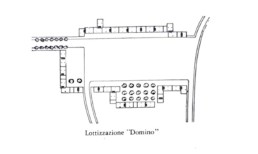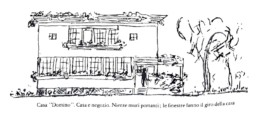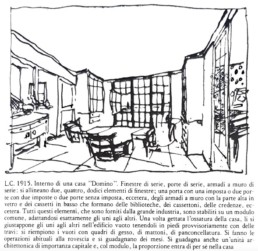Mass-produced housing – Le Corbusier, Towards a New Architecture
Loucheur e Bonnevay ask the government for a law authorising the construction of five hundred thousand affordable homes. It is an exceptional circumstance in the annals of construction, requiring exceptional means and methods.
Now it is all to do: nothing is ready for the realisation of this ambitious programme. The spirit is lacking.
The spirit for mass-produced housing, for living in mass-produced housing, for designing mass-produced housing.
Everything has yet to be done: nothing is ready. Specialisation has barely approached the field of construction. There are no factories or specialised technicians.
But in the blink of an eye, if such conditions were to emerge, everything could be quickly set up. Indeed, all branches of construction, industry, as potent as a force of nature, bursting forth like a river that runs down to the sea, increasingly tends to transform the raw materials that nature provides and to produce what we call “new materials”. There are a great many of them, cement and lime, steel girders, sanitary fittings, insulating materials, pipes, small parts and impervious ducts, etc, etc. All of this is dumped haphazardly into the building under construction, costing a fortune in manual labour and providing bastard solutions. Because the various components used are not mass-produced. Because, lacking the spirit to do it, there has been no rational study made of the components nor, above all, of construction technique itself. The spirit of mass-production is hateful to architects and home-dwellers (through contagion and persuasion). Just think, we are barrelling towards to r-e-g-i-o-n-a-l-i-s-m! What a bore! And the most ludicrous thing about it is that it is the destruction in the occupied areas that has got us there. Faced with the immense task of total reconstruction, Pan’s pipes have been taken down from their display case. They’re being played here, there and everywhere by committees and commissions. Then resolutions are voted on. This, for example, which merits a mention: putting pressure on the Chemins de Fer du Nord company to force it to build thirty stations in different styles on the Paris – Dieppe line so that the thirty stations, which express trains speed through one after one, each have a little mound and an apple tree to adorn them and represent their character, their soul , etc. Pan’s pipes have led to this!

Pictures from Le Corbusier’s book “Towards a New Architecture”.
The prime consequences of the industrial building revolution are shown in this initial stage: the replacing of natural materials with artificial materials, of heterogeneous and dubious materials with homogeneous and laboratory -tested artificial materials and products of fixed composition. Artificial materials must replace infinitely variable natural materials. On the other hand, the laws of Economics clamour to be heard; steel girders and, more recently, reinforced concrete are pure manifestations of calculations, which use the material economically whilst ancient wooden beams might conceal some traitorous knots and their squaring produce a considerable waste of material. Finally, in certain fields, it is the technicians who have had their say. Water or electricity services are rapidly evolving. Central heating has begun to take into account the structure of walls and windows – cooling surfaces – and, consequently, stone, good natural one-metre thick stone, has been replaced with light cavity walls and so on. Things which were accepted, almost worshipped as divinities, have fallen by the wayside: roofs that no longer need to be sloping to allow water run-off ; large beautiful window embrasures which annoy us because, hemmed in by walls, they imprison the light; massive timber beams that are the thickness that was required at the time and infinitely solid split near a radiator, while three millimetre thick plated metal remains intact, etc… Once we saw (but alas we still see it today) sturdy horses which carried enormous stones to building sites and many men unloading them from carts in order to break them, dress them, hoist them onto scaffolding, and place them in position, measuring their six sides with rule in hand. A house was built in two years while now buildings go up in a few months. The P.O. is about to finish its immense refrigeration (cold storage) plant in Tolbiac. The only things to enter the building site were grains of sand and bits of iron slag the size of nuts. The walls are as thin as membranes. In this building there are thin partitions to protect against variations in temperature and eleven centimetre iron beams that bear enormous loads. Things have indeed changed!
The transport crisis has posed drastic problems. It has come to everyone’s attention that houses represent a formidable tonnage. What if this tonnage were reduced by four fifths? That is the modern way of thinking.
The war has shaken people out of their torpor. Taylorism was discussed and then acted upon. Contractors have purchased clever, patient and agile plants. Will building sites soon be factories? Will houses be poured into a mould from above, in the space of a day, as though filling a bottle. And, in short, after making guns, aeroplanes, lorries and wagons in factories, one might well ask: why not houses? This is the spirit of our age. Nothing is ready but everything can be readied. In the twenty years to come industry will standardise mass-produced materials, as in metallurgy. Technical advances will take heating and lighting systems and the rationality of structures far beyond anything we know now. Building sites will no longer be sporadic apparitions where there is nothing but higgledy-piggledy confusion. Financial and social organisation will, with concerted and potent methods, solve the housing question, and building sites will be immense and run administratively. Urban and suburban developments will be vast and orthogonal and no longer dismal congeries. This will allow the use of the mass-produced element and the industrialisation of building sites. Finally, we will perhaps stop “custom-made” building. The inevitable evolution of society will transform relationships between tenants and owners and modify the concept of living. Cities will be more ordered and less chaotic. The home will no longer be that solidly built thing that sets out to defy time and that item of luxury with which one shows off one’s wealth. It will be a tool just as the automobile is a tool. The home will no longer be an archaic entity, heavily rooted to the ground with deep foundations, built to last, and to whose worship the cult of family, race etc has been devoted for a long time.

Eradicate from your heart and spirit any hard and fast conceptions in regard to the home and look at the question from an objective and critical angle, and you will inevitably arrive at the “House-Tool,” the mass-produced home, available to everyone, incomparably healthier than the old kind (and morally healthier too) and beautiful in the same sense as familiar work tools are beautiful.

And it will also be beautiful with the vitality that an artist’s sensibility can bring to its stark and pure organs.
But it is essential to create the right state of mind for living in mass-produced homes .
Everybody, quite rightly, dreams of building a safe shelter. This dream, because it is currently impossible is deemed incapable of realisation and so provokes a real state of sentimental hysteria ; building one’s own home is very much like making
one’s will. . . . When I build my home…I will put a statue of myself in the vestibule and my little dog Katty will have her own room. When I have a roof over my head that belongs to me, etc… It is a matter for a neurologist.
When the time does arrive to build this home, it is not the mason’s nor the engineer’s moment, but that moment in which every man produces a more or less successful poem in his life. And so, in the last forty years in our cities and their suburbs , we have had not so much houses as poems, poems of an Indian summer, for a home is the crowning of a career … That very moment when a man is sufficiently old and worn-out by life to fall prey to rheumatism and to death . . . and to crazy ideas.

A question of a new spirit : I am 40 years old, why should I not buy a home for myself for I need this tool ; a home built on the same principles as the Ford car I bought (or my Citroen, because I’m vain).
Collaborators already consecrated to the task: big industry, specialised factories.
Collaborators who must be brought in : suburban railway lines, financial organisations, transformed Schools of Fine Arts.
The aim: mass-produced homes.
The coalition: one of architects and men of taste and the universal love of the home.
The executives: business concerns and true architects.
Irrefutable proof:
1. The Airshow ; Towns celebrated for their beauty (the Venetian Procuracies, the rue de Rivoli, Place des Vosges, la Carriere, Versailles, etc.: all mass-produced). For the mass-produced home automatically implies generous and ample plans. It necessitates the
minute study of every detail connected to the home, and a quest for a standard, for a type. When this type has been created, beauty is a step away ( cf. the motorcar, the liner, the lorry, the airplane). For the mass-produced home will impose unity in its various elements, windows, doors, methods of construction, materials. Unity in detail and in the overall project. This was the demand, in Louis XIV’s reign, in the muddled, congested, inextricable and uninhabitable Paris of that time, of a very intelligent abbot, Laugier, who busied himself with town-planning: Uniformity in detail and tumultuous variety in the overall effect (the exact opposite of what we do to-day : a tumultuous variety in details, and a deadly uniformity in the laying out of our streets and towns).
Conclusion : We are dealing with an urgent problem of our epoch, nay more, with the problem of our epoch. Social equilibrium boils down to a question of building. We end with these justifiable alternatives: Architecture or Revolution.
